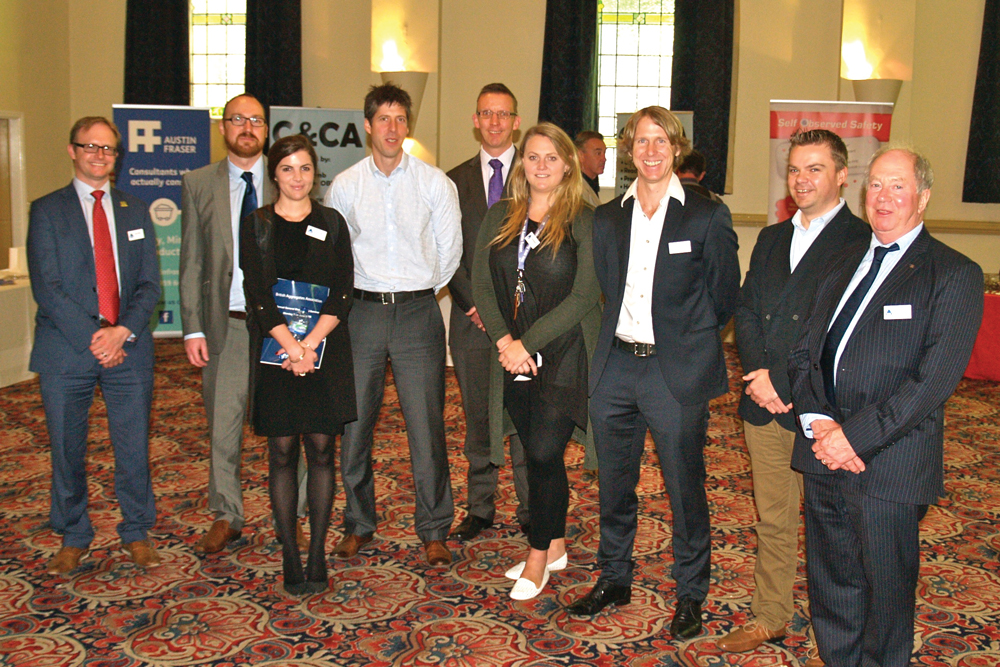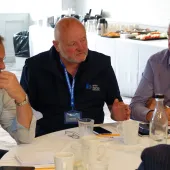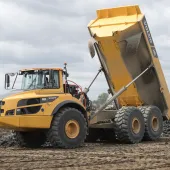British Aggregates Association’s 2016 Conference

First published in the July 2016 issue of Quarry Management as A Packed Programme
QM reports on the British Aggregates Association’s 2016 seminar proceedings
If it takes 15 minutes for a truck to get into your quarry, loaded and out again, shaving three minutes off that time could produce savings of nearly £60,000 a year. How do you speed up the turn-round time by three minutes? Automate.
That was the message from David Taylor, UK sales manager of quarry automation company Command Alkon, when he spoke at this year’s British Aggregates Association (BAA) annual seminar.
As usual in a Hillhead exhibition year, the BAA held its seminar and annual general meeting at the Palace Hotel in the Derbyshire town of Buxton the day before the exhibition opened at the nearby Hillhead Quarry in the High Peak.
With 12 presentations on the programme, as well as the Quarry of the Year Award and lunch to fit in, and a visit to the stands of the six companies supporting the event, the annual gathering runs at brake-neck speed until the rather more relaxed annual dinner in the evening.
Nearly 100 people were involved this year, being updated on a wide range of issues, from David Taylor’s advocacy of automation to the exploration of environmental issues by Martin Layer of quarry company Smiths Bletchington and Jim Davies of the Environment Agency.
The speakers were generally trying to convince their audience that it is in minerals companies’ own best interests to operate in a modern, professional, safe way, even (or perhaps especially) when it comes to health and safety, which is not always companies’ favourite subject. But the argument goes that rather than being seen as a cost, health and safety should be seen as a route to greater efficiency and a higher level of customer satisfaction (not to mention a way of avoiding fines and compensation for injuries and industrial diseases, with the costs involved in both increasing rapidly).
The subject of the size of fines associated with health and safety infringements was addressed specifically by Tom Cleary, a lawyer with Knights Professional Services. New guidelines on sentencing in health and safety prosecutions were introduced in February this year, with the result that fines since then have been much higher – an average of just short of £160,000, which is a five-fold increase.
Balfour Beatty, for example, were fined £2.6million with £54,000 costs after an employee was killed when the unsupported trench he was working in collapsed on him. Balfour Beatty said the company the man had been working for was dormant but the court fined them anyway.
Another fatality involving a smaller company resulted in a £750,000 fine, and a fine of £3 million was imposed on a gas company for a major leak, even though nobody was hurt, and in another case a gas fitter was sentenced to 18 months’ imprisonment.
Tom Cleary explained how the guidelines for penalties in health and safety breaches are now quite specific and are intended to be too high to be considered an acceptable risk by companies. The aim is to make it less expensive to improve health and safety in the workplace than to be prosecuted, so companies will take action before somebody is hurt.
As a result of the new guidelines, companies are now putting in place crisis-management plans to deal with the possible outcomes of a prosecution. Mr Cleary also said companies had become more willing to contest a prosecution rather than accepting fault, as they had tended to do in the past. This was increasing the costs to the courts as well as providing more work for lawyers.
A health and safety issue addressed specifically by Nick Warren of the Health and Safety Executive (HSE) was silicosis. This is caused by breathing in high silica content dust of about 5 microns in size (known as respirable crystalline silica, or RCS). Bigger than that and it tends not to reach the lungs and any smaller and it goes in and comes out again. But at around 5 microns it goes in, stays in and, for those vulnerable to it, damagesnd premature death.
Sand, sandstone, granite and slate all have a high silica content; limestone and marble a low silica content. But all stone contains crystalline silica, which means so does all concrete. Bricks also contain silica, and in a separate study into the levels of RCS in the air at brickworks over a decade, 20% of the readings taken showed the level was above the legal limit and that it had not reduced over the years.
Mr Warren said there is no safe level of exposure to RCS. At 0.025mg of RCS in a cubic metre of air, 2% of those exposed for 45 years would contract silicosis. At 0.5mg, the exposure limit in America, 12 people in 100 would contract the disease. At 0.1mg, the exposure limit in the UK, 30% of people would contract silicosis. The EU is currently planning to take a lead from the UK and reduce exposure limits across Europe to the UK’s level (or it was before 23 June, whether that move will now continue or not remains to be seen).
Many people who contract silicosis do not know they have it until later in life when it starts noticeably restricting their mobility. The reason is that the disease reduces lung function by 8ml a year. In comparison, smoking reduces it by 12ml a year. An average adult would have a lung capacity of 2–3 litres. As the capacity slowly reduces over time the effects become more obvious.
The HSE carried out a study of 700 volunteers, mostly in their 40s, working in various industries where they could be exposed to RCS. Just over 10% of those tested had some level of airway obstruction and were X-rayed, with 1.5% of those people turning out to be suffering from silicosis, although they were still working*.
Mr Warren said this showed the importance of monitoring the health of workers who could be exposed to RCS and removing them from any further potential exposure if they showed any signs of losing lung function. He said: ‘Removing people from further exposure slows, but doesn’t prevent, the progress of silicosis towards a more severe state.’
The HSE has developed a computer model that allows it to predict how levels of exposure will be reduced over time at an individual, site, industry and national level in response to different policies being adopted.
Another health threat to people working in the minerals extraction industry is tinnitus brought about by exposure to some of the noisier processes. David Stockdale from the British Tinnitus Association spoke about that.
Tinnitus is a noise in the ears. It is usually ringing or buzzing but can be other noises as well, even words or music, which often goes unreported because the person hearing such noises thinks they are experiencing a mental disorder. Ears are an organ and organs work best in a body that is properly hydrated, so drinking water can help.
Mr Stockdale said nobody knows why one person can find tinnitus maddening while another can live with it without undue distress, nor why some people with hearing loss get it and others with the same level of hearing loss do not.
Apparently, 10% of the population have it, irrespective of age. Anything that blocks or damages the ear can lead to tinnitus but so too can stress and anxiety, and, of course, a common cause is noise. Exposure to 106 decibels (dB) for 33/4 minutes will cause damage to the hearing that can result in tinnitus. That is why the British Tinnitus Association is launching a campaign called Plug’em in September to promote the use of ear protection.
As well as protecting the people who work for them, minerals extraction operations are also expected to protect the environment, which, once again, is in their own self-interests if they expect to get planning permission in the future.
Different aspects of managing the environmental impact of minerals extraction were presented by Mark Dowie of Bruel & Kjaer, John Mills of the Royal Society for the Protection of Birds (RSPB), and Lili Pechey and Chris Eves of AECOM, as well as by Martin Layer and Jim Davies.
Mark Dowie specializes in noise and vibration, which can be used by objectors as reasons to limit the expansion or operation of minerals extraction and associated businesses.
His advice is to be open about your activities in order to keep local residents on your side. He said operators should be clear and honest about what they would be doing and the impacts of it so residents would trust what they say. ‘By having a dialogue with communities they will be more tolerant of you,’ he said.
He added that opposition usually came from a small number of activists who would never change their minds, so it was probably not worth trying to appease them. Instead, get the majority of the people in a community on your side to deprive the activists of wider support for their cause.
He said companies using Bruel & Kjaer monitoring systems could identify problems of vibration and noise and address them before they became problems with the local community. The company would also have recorded data to prove how the problem had been ameliorated or eliminated.
Another approach to addressing the trade-off between the environment and the extraction of natural resources from it is to put a monetary value on the environment. This is one way of helping governments, businesses and organizations reach decisions, and it is one of the ways AECOM are helping in 150 countries.
Lili Pechey, an environmental economist with AECOM, and Chris Eves, an environmental consultant, explained to members of the BAA how they had worked with public and private sector clients to reach informed trade-offs between natural and financial capital.
This year had seen the first meeting of the Natural Capital Coalition’s Operations Group, led by AECOM. The Coalition has developed a Natural Capital Protocol, due to be launched this month, for putting values on natural capital.
Putting a monetary value on something, such as the creation of a particular habitat for wildlife at the end of a quarry’s life, can make stakeholders aware of trade-offs involved between public and private returns. It also encourages quarries to bear the cost of restoration because they can see the benefits to them of doing so.
And when it comes to restoration, who better to offer advice than the Royal Society for the Protection of Birds. That, at least, was John Mills’ proposition. He has been the RSPB Nature After Minerals (NAM) planning advisor since 2012, helping extraction companies restore their sites as habitats relevant to the wider landscape.
Just the week before the BAA conference, the RSPB launched its new NAM website (www.afterminerals.com), ‘a resource for quarry restoration and minerals planning for biodiversity gain’, as it says on the site’s home page.
Mr Mills said people tended to associate more with a particular species than a general landscape, so the RSPB is talking to mineral producers about how they can help stop the decline of priority species such as bitterns, willow tits, turtle doves and sand lizards.
He said the RSPB wanted to run events to highlight these priority species in the autumn and spring and he asked any company that would like to host such an event to contact NAM (details are on the website).
Martin Layer of Smiths Bletchington spoke from an operator’s perspective on the difficulties that have been involved in using inert waste for quarry restoration. Because of the way waste licensing was being interpreted vast quantities of material for land restoration had been going into sham projects and golf courses. The industry had complained it was being over-regulated and Mr Layer outlined the developments that had taken place since 2006, leading eventually to inert waste for restoration being classed as recovery not disposal, which is what it had wanted.
And just in case anyone was thinking that the referendum vote to leave the European Union on 23 June means they can ignore environmental legislation, Jim Davies from the Environment Agency put them right. ‘Brexit doesn’t change anything,’ he said...well, not for now, anyway. The full set of conference reports are available to BAA members on the BAA website: www.british-aggregates.co.uk
*To get some idea of what it is like to have silicosis, watch an HSE video of a man who is suffering from it and a report by a man who has since died of it following a lung transplant at: bit.ly/stone-silicosis
• Subscribe to Quarry Management, the monthly journal for the mineral products industry, to read articles before they appear on Agg-Net.com








